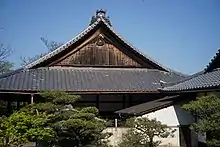| Manju-ji 万寿寺 | |
|---|---|
 | |
| Religion | |
| Affiliation | Tōfuku-ji Rinzai |
| Deity | Amida Nyorai (Amitābha) |
| Status | Five Mountain Temple (Kyoto) |
| Location | |
| Location | 15-Chōme 786 Honmachi, Higashiyama-ku, Kyōto, Kyoto Prefecture |
| Country | Japan |
| Geographic coordinates | 34°58′52.1″N 135°46′15.9″E / 34.981139°N 135.771083°E |
| Architecture | |
| Founder | Emperor Shirakawa |
| Completed | Heian period (late 13th century) |
Manju-ji (万寿寺) is a Rinzai Buddhist temple in Higashiyama-ku Kyoto, Japan.[1] Owing to the influence of the Ashikaga, Manju-ji was designated a Jissatsu temple for a time. At present, it is a sub-temple of Tōfuku-ji.[2] It is considered to be one of the so-called Kyoto Gozan or "five great Zen temples of Kyoto".
History
Manju-ji was founded in the middle Heian period (late 13th century).[3] In 1305, Nanpo Shōmyō (南浦紹明) (1235–1308) was appointed abbot of Manju-ji.[4]
Artwork
An artistically noteworthy Amida figure is too large to be moved from Manju-ji for display elsewhere.[5] The temple holds a collection of esoteric Buddhist art which was traditionally used in teaching the salient points in the story of the life of Gautama Buddha.[6]
See also
- List of Buddhist temples
- List of Buddhist temples in Kyoto
- For an explanation of terms concerning Japanese Buddhism, Japanese Buddhist art, and Japanese Buddhist temple architecture, see the Glossary of Japanese Buddhism.
Notes
- ↑ Iwao, Seiichi et al. (2002). Dictionnaire historique du Japon, p. 1742.
- ↑ Baroni, Helen Josephine. (2002). The Illustrated Encyclopedia of Zen Buddhism, p. 214.
- ↑ Japan Cultural Profile: "Buddhist architecture in the Kamakura period (1185-1333)"
- ↑ Joint Council for Japanese Rinzai and Obaku Zen: "Transmission of Zen to Japan"
- ↑ McCallum, Donald F. "Heian Sculpture at the Tokyo National Museum. Part II: A Review Article," Artibus Asiae, Vol. 36, No. 1/2 (1974), pp. 147 n3.
- ↑ JAANUS (Japanese Architecture and Art Net Users System): Shaka hassou (釈迦八相, Sha-ka-has-sou).
References
- Baroni, Helen Josephine. (2002). The Illustrated Encyclopedia of Zen Buddhism. New York: Rosen Publishing Group. ISBN 978-0-8239-2240-6; OCLC 42680558
- Dumoulin, Heinrich. (2005). Zen Buddhism: A History (Vol. II: Japan). Bloomington, Indiana: World Wisdom. ISBN 978-0-941532-90-7
- Iwao, Seiichi, Teizō Iyanaga, Susumu Ishii, Shōichirō Yoshida, et al. (2002). Dictionnaire historique du Japon. Paris: Maisonneuve & Larose. ISBN 978-2-7068-1632-1; OCLC 51096469
- Ponsonby-Fane, Richard Arthur Brabazon. (1956). Kyoto: The Old Capital of Japan, 794-1869. Kyoto: The Ponsonby Memorial Society.
This article is issued from Wikipedia. The text is licensed under Creative Commons - Attribution - Sharealike. Additional terms may apply for the media files.